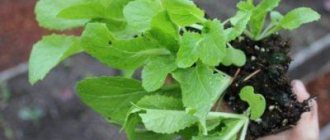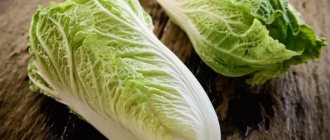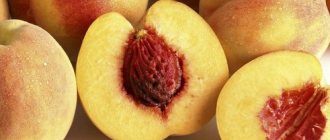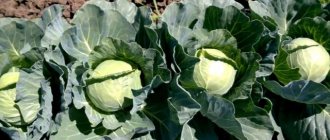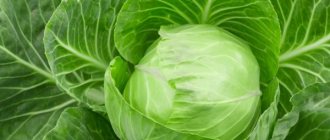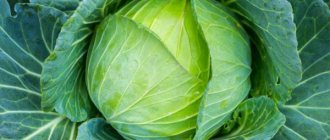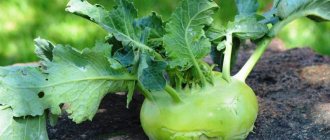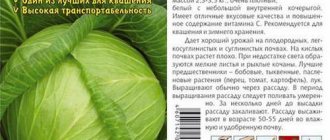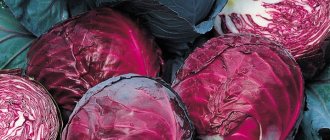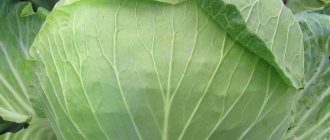Vegetable growing » Cabbage
0
1072
Article rating
Kira Stoletova
Cabbage varieties for Siberia were bred taking into account the climatic characteristics of this region. They have increased cold resistance, are resistant to constant weather changes and are resistant to a number of major diseases.
The best cabbage varieties for Siberia
The best varieties of white cabbage for Siberia
are preferred for Siberia. The most popular type, which is often grown for pickling and pickling, is white cabbage. Before planting in open soil, the seeds must be germinated into seedlings. None of the local gardeners recommend planting seeds directly in open ground, except perhaps under a greenhouse.
Early varieties of white cabbage for Siberia
The best cabbage varieties for Siberia are Nadezhda, Polyarny K-206 and Vyuga . They withstand the harsh conditions of the local climate and produce high yields. In terms of parameters, the fruits are the same, medium in size. From one square meter you can collect up to 5-7 heads weighing up to 4.5 kg.
Hybrid varieties of white cabbage for Siberia
Hybrid varieties of white cabbage have also proven themselves well: Zarya, Dumas, Gribovsky .
Mid-season varieties of white cabbage for Siberia
Among the mid-season varieties, the best varieties of white cabbage for Siberia are Podarok, Sibiryachka, Slava-1305, Belarus, Yubileiny F1. They are most often grown in garden beds at summer cottages.
Late varieties of white cabbage for Siberia
Late white cabbage is grown less frequently in Siberia. The purpose of planting it is to plan for longer fresh storage. Among the popular varieties are Zimnaya Gribovskaya, Amager, Dobrovodskaya, Amtrak F1 .
Broccoli varieties for Siberia
The following varieties of broccoli cabbage for Siberia are popular:
Broccoli variety - Caesar F1
An early ripening variety , the harvest of which can be harvested several times per season, even in the Siberian climate.
After cutting off the heads, the plant quickly forms a new ovary.
Summer residents choose it because it has amazing taste and has the ability to maintain freshness for a long time during long-term storage.
The average weight of the head is 600-900 g. Also, the variety is not affected by many common cabbage diseases.
Broccoli cabbage variety - Vitamin
Early variety. From the moment the seedlings are planted in the soil, they can produce the first harvest within 65-70 days. The weight of the heads is not large (up to 250 g)
Timely harvesting is recommended. Cabbage is very tasty, but does not last long. It should be eaten immediately or preserved.
Many people believe that the Siberian climate is very unsuitable for growing cabbage. But this is by no means true. Many summer residents have already learned how to grow this garden crop; they select the appropriate varieties and successfully receive a decent reward for their work.
Features of harsh climatic regions
In Siberia, most of the space in industrial greenhouses is used for growing white cabbage, but cauliflower has not taken root due to its fastidiousness in care.
But this did not stop Siberian gardeners, using the achievements of breeders in developing new frost-resistant varieties and hybrids, to grow cauliflower in their gardens using seedlings. Their experience confirms that the conditions in the southern and middle latitudes of Western Siberia are quite favorable for this crop, if you choose the right variety and do not make a mistake with the time of sowing seeds and transplanting seedlings into open ground.
When and how to sow seeds
The time at which cabbage seeds should be sown may vary depending on the length of the period of growing seedlings and the timing of planting in a permanent place. Approximate dates for sowing seeds of almost any type of cabbage for growing in Siberia:
- cabbage of early and ultra-early varieties and hybrids - the first ten days of March;
- cabbage varieties and hybrid forms with medium ripening periods - second half of April;
- late-ripening varieties and hybrids of cabbage - the last ten days of March or the beginning of April.
The seed sowing rate, provided there is no picking of seedlings, is:
- early ripening varieties and hybrids - about 1.5-2.0 g per square meter, with a standard feeding area of 6x6 cm or 7x7 cm and a duration of growing seedlings of 45-60 days;
- mid-season varieties and hybrids - about 3.0-5.0 g per square meter, with a standard feeding area of 5x5 cm or 6x6 cm and a duration of growing seedlings of 35-45 days;
- late-ripening varieties and hybrids - about 4.0-5.0 g per square meter, with a standard feeding area of 5x5 cm or 6x6 cm and a duration of growing seedlings of 40-45 days.
Seeds that have undergone preliminary preparation should be planted at a depth of one centimeter. To maintain optimal moisture levels, it is recommended to cover the crops with film. If the temperature conditions are observed, mass shoots appear approximately on the fifth day, after which the shelter can be removed.
Fertilizers for cabbage in Siberia
On acidic soils in the fall it is necessary to carry out liming (for digging), otherwise the effectiveness of fertilizers sharply decreases. Because lime contains calcium, this necessary element is immediately introduced. Another reason for liming is that clubroot disease develops in acidic soils.
The need for nutrients depends on the planned yield and the content of nutrients in the soil. You can calculate the fertilizer application rate for carrots without the help of others (see calculating the fertilizer application rate). Approximately on soddy-podzolic soils for cabbage, the following fertilizer application rates can be recommended: urea 40-45 g/m2, double superphosphate 30-35 g/m2, potassium sulfate 40-45 g/m2. Nitrogen fertilizers can be applied for spring tillage and fertilizing, phosphorus and potassium fertilizers are better for autumn digging (phosphorus fertilizers can also be used for fertilizing).
Cabbage is a big fan of organic fertilizers. They try to add manure under it, the norm is 6-8 kg/m2. When applying organic fertilizers, the rate of mineral fertilizers is reduced. If you are a supporter of organic farming, then you can completely abandon mineral fertilizers, replacing them with organic ones (especially since cabbage responds well to the application of organic fertilizers, especially rotted manure and humus).
For early varieties, application rates are reduced, especially nitrogen fertilizers, because early cabbage can accumulate a lot of nitrates.
Influence of atmospheric phenomena
The climate of Siberia affects the cultivation of cauliflower not so much by its severity as by the lack of daylight hours. Cauliflower develops well and forms large dense heads at temperatures from 15°C to 20°C, and daylight hours should last 13-15 hours. Moreover, even hardened seedlings of cold-resistant varieties cannot withstand spring frosts with temperatures below -5° WITH.
So it turns out that seedlings in Siberia need to be planted in open ground as early as possible, since already in July the temperature during the day is above 23°C, and the daylight hours are longer, otherwise the inflorescences will be small and loose. But at the same time, you need to try not to plant it too early, otherwise the frozen bud buds will rot when thawed.
Harvesting and storing cabbage in Siberia
Cabbage is considered one of the most frost-resistant vegetables, capable of growing in the garden even at sub-zero temperatures. Despite this feature, you should under no circumstances delay the harvest. Even if the cabbage looks good immediately after harvesting, there is a high probability that it will begin to crack during subsequent storage. Cracks, in turn, are a good target for bacteria, and also speed up the rotting process significantly. There is also no need to rush to remove cabbage from the soil, since haste will not allow the forks to fully form. The vegetable will turn out to be loose and not the most pleasant to taste.
Rating of red cabbage varieties
Red cabbage varieties are less common in Russia, but in vain. In terms of the content of vitamins and microminerals, they can easily outperform their white cabbage “relative.” The vegetable is stored for a long time, has a pleasant taste, and has excellent dietary characteristics.
“Blue” cabbage is often used in fresh salad recipes and used as a side dish. There are types that can be pickled and fermented for the winter.
Various seeds can be planted directly into the ground or pre-sown under cabbage seedlings. Red cabbage takes longer to ripen, but is practically not afraid of pests, frosts, and typical “garden” diseases.
Experienced farmers recommend harvesting as late as possible. It is better if the cabbage “survives” the first frost while in the ground. Cold will not spoil the quality of the product if you allow the root to thaw, and this will only improve the taste.
Kalibros (Kalibos) – for lovers of beauty in the garden
This variety of cabbage is the real queen of the garden bed. No other type of vegetable can boast such an unusual teardrop-shaped shape. The heads of cabbage, elongated in the form of a rose bud, are a pity to pick, let alone eat. But it is impossible to resist the temptation - Calibos perfectly reveals its taste in any dish. Due to its delicate structure without rough veins, cabbage can even be eaten fresh.
The juicy, sweetish leaves have a deep red-violet color and form dense leaves weighing up to 2.5 kg. As a rule, 120 days are enough for the crop to ripen. The plant copes well with temperature changes and is not afraid of moderate frosts or high humidity. Supplies can be stored for up to four months.
Onions - description of 33 varieties with their photos and main characteristics, ripening periods and other useful information (Video) + Reviews
Gako 741 – for conservative summer residents
Gako is the most recognizable variety of “blue” cabbage in the CIS countries. It is classified as medium-late; usually vegetables are ready for consumption 5 months after planting. Mature heads of cabbage are large in size, weighing up to three kilograms. Flattened, rounded forks are formed from purple-gray leaves with a waxy texture.
Gako 741 is unpretentious and grows well in problematic soil. You can store vegetables until the start of a new season - over time, the taste becomes even softer and more pleasant, and the “bitterness” disappears.
Primero – for those who need it faster
Summer residents love Primero for its versatility. The seeds are very productive, suitable for early planting and late season planting. Primero ripens faster than other representatives of the rating; plants are ready for harvest in 75-80 days. Another argument is resistance to cracking, frost, and typical diseases.
Primero forks have a rich purple color with contrasting white veins. The leaves are juicy and not bitter. On average, one head of cabbage weighs up to two kilograms. They can be grown for home consumption in salads and even for sale - the plant is perfectly preserved during transportation and looks attractive.
Varna – for the most thrifty
Varna F1 is a Japanese hybrid that has already been appreciated by many gardeners. The variety attracts with its beautiful shape and neat appearance, is stored for a very long time, and is not demanding on the watering regime. The harvest ripens within three months after planting. Cabbage has bright purple elongated heads. Due to their density, small-looking heads of cabbage weigh up to three kilograms.
Delicious salads and pickles are prepared from this cabbage variety. Caring for the plant is very simple - it tolerates heat well and practically does not get sick. From one meter plot of land you can get up to 10 kilograms of vegetables.
Mid-season varieties
Mid-season varieties of white cabbage are most often grown by summer residents and villagers, since they are best suited for pickling - the favorite method of preparing cabbage in Russia.
Distinctive features:
- the growing season is 130-170 days, they begin to ripen when the early varieties are already leaving;
- fork density is average,
- the leaves are juicy, white inside, contain a lot of sugars;
- high productivity,
- best for pickling and canning,
- They are not stored for long, maximum until the New Year.
Universal mid-season varieties
Slava 1305
For almost 80 years, this variety has remained the most beloved among the people, despite the huge number of new products. Sweet and juicy Slava leaves are very tasty fresh and are great for pickling. The forks gain weight by 2.4-4.5 kg. They are not stored for long, 2 months.
Belorusskaya 455
Another popular old variety. Very good for fermentation and can be stored fresh until the New Year. The forks are dense, weighing 1.3-4.1 kg, and do not crack.
Hope
The most productive mid-season cabbage of domestic selection. Ripens in August, stored until February. Tasty both pickled and fresh. Dense forks weighing 3.0-3.5 kg do not crack. The average yield is 7.5-11.9 kg/m.
Rinda F1
Mid-season Dutch hybrid from Monsanto. The forks are dense, with a pleasant taste, and are stored on the root for a long time. The inner leaves are white with a yellow tint. It is unpretentious to growing conditions and can be re-sowed in summer. Delicious both fresh and canned. Stored until the New Year. Head weight is 3.3-3.6 kg, very productive, about 9 kg/m.
Present
Mid-late variety of 1960, selected by VNIISSOK. Disease-resistant, stored for 6 months. The heads of cabbage are very dense, weighing 2.6-4.4 kg, and do not crack. From one sq. m you can collect up to 10 kg of cabbage. Tasty, good for pickling.
Megaton F1
A mid-late, very productive hybrid from the Dutch company Bejo Zaden. Cold-hardy, resistant to clubroot, gray rot, fusarium wilt. Can be planted more densely than other varieties. The heads of cabbage grow up to 10 kg, are tasty, and very good when pickled. Stored until January. Suitable for growing for sale in large farms.
Mid-season varieties for the North, Urals and Siberia
Cabbage is a cold-resistant plant and can grow normally at temperatures of 10-15 degrees. Almost all universal mid-season varieties grow well in regions with short, cool summers. But there are several bred specifically for the North, the Urals and Siberia.
Siberian 60
Mid-season, ripens a week later than Belarusian. Tolerates cold weather well. The forks are moderately dense, weighing 2.1-4.3 kg, and do not crack. Good both fresh and pickled. Can be stored for up to 4 months. Productivity 3.4-8.6 kg/m.
Florin
Middle late, zoned across Eastern and Western Siberia. Rarely gets sick. The forks are dense, weighing 2.3-4.5 kg, do not crack, and have good taste. Florin is grown for winter storage and fresh consumption.
Best varieties to grow in this region
Quite a lot of early, mid-early and even ultra-early varieties and hybrids of Chinese cabbage have been bred. These are both foreign developments and the achievements of Russian breeders. Among the latter there are those that were specially created for cultivation in the Urals, Siberia, and the Far East. Therefore, as a rule, there are no problems with purchasing seeds. But it is better to find out in advance about the advantages of the varieties offered so that the choice is informed. You also need to pay attention to possible problems.
The following varieties and hybrids are most popular among Russian gardeners:
- Richie F1. A mid-early ripening hybrid originally from France. It entered the Russian State Register in 2008. Heads of Chinese cabbage are quite dense and small (up to 0.8 kg). Despite this, their shelf life is minimal. Cabbage is eaten fresh or used to prepare your favorite dishes. The hybrid has “innate” immunity to any type of bacteriosis. The rosette is semi-vertical, the leaves are of a rich green hue, not particularly large. The head of cabbage is elongated, pale yellow in cross section. The surface is “bubbly”. The central vein is moderately expressed. The taste deserves only positive reviews. But the yield is low, only 2.1 kg/m².
- Nika F1. A mid-early hybrid, in Siberia it is most often cultivated in greenhouses or greenhouses. Heads of cabbage ripen in 50–60 days. A significant advantage is the presence of absolute immunity to clubroot. Also, this cabbage extremely rarely goes into the arrow. The leaves are large, very juicy, covered with a thin layer of bluish-purple waxy coating. The heads of cabbage are broadly oval and reach a weight of 2–3 kg. Due to the large weight, the yield is very high - 10–12 kg/m². The outer leaves are pale green; when cut, the head is white-yellow.
- Khibinskaya. In open ground, heads of cabbage ripen in 40–50 days, under film cover - in a month or even a little less. The yield also varies accordingly - from 2–3.5 kg/m² to 4–7 kg/m². The variety was bred in the early 60s of the twentieth century and takes root in any climate with the exception of the Arctic and subarctic. The heads of cabbage are cylindrical, half-open. The leaves are strongly wrinkled, large, there are many of them, but the rosette is not spreading, 20–35 cm in diameter. The edge of the leaf plate is corrugated, “curly”. The veins are wide and flat, white. Lettuce-colored leaves with a yellowish tint. This cabbage goes into arrow mode relatively rarely and does not suffer from droughts.
- Northern beauty F1. Mid-early hybrid, resistant to bolting and various types of rot. The growing season is 50–55 days. The heads of cabbage are dense, barrel-shaped, reaching a weight of 2.8 kg. The peculiarity of the hybrid is the presence of amino acids and pectin in high concentrations.
- Orange Mandarin F1. A very popular hybrid that ripens in 40–42 days. Even in Siberia, when grown in open ground, you can have time to harvest two crops during the summer. It is extremely rare for a gardener to fail, despite the vagaries of the weather and temperature changes. The rosette is wide, squat, about 45 cm in diameter. The heads weigh about 3 kg, the leaves are very juicy. The outer leaves are pale green, the core is bright orange. This is due to the high carotene content.
- TSHA 2. Achievement of Russian breeders, the variety was bred in the early 90s of the last century. It successfully takes root and bears fruit in most of Russia. Recommended for cultivation in greenhouses and greenhouses. Doesn't shoot. The height of the plant reaches 40–45 cm, the diameter of the rosette is about 30 cm. The leaves are elongated, with a corrugated edge, covered with a thin layer of bluish bloom. The vein is wide and flat. The head of cabbage is loose and weighs approximately 0.55 kg. The yield is not bad - 4.5–7.5 kg/m². A significant drawback is the tendency to be affected by mucous bacteriosis and “black leg”.
- Victoria F1. A mid-early hybrid originally from the Netherlands. Heads of cabbage form on average in 50–55 days. They are very dense, slightly elongated in shape, reaching a mass of 2 kg. You can count on 8–10 kg/m². Compared to most varieties of Chinese cabbage, the keeping quality of the hybrid is very good. This cabbage can be stored for up to three months. The plants do not bolt and are immune to all the diseases most typical of Chinese cabbage. The hybrid is demanding on watering and fertilizing.
- Russian Size F1. A mid-season hybrid (70 days), but due to its resistance to unfavorable weather and climatic factors, heads of cabbage have time to form in Siberia. They are unusually large, weighing about 4 kg. The outer leaves are bright green, the core is yellowish-cream. The hybrid is undemanding to growing conditions and can forgive the gardener certain flaws in agricultural technology. A characteristic feature is an increased concentration of vitamin C and macroelements and the presence of “innate” immunity to common cabbage diseases. Plants tolerate both low and high temperatures well.
- Cha-Cha F1. Heads of cabbage ripen in 50–55 days. They are quite large, up to 2.8 kg. Plants feel good during drought, cabbage does not go into decline. The heads of cabbage are dense, cylindrical, pale green. They form even with non-optimal daylight hours.
- Yuki F1. Another French hybrid. Recommended for growing indoors. Valued for disease resistance and transportability. Can be stored for 4–6 weeks. The socket is semi-raised. The leaves are medium or large, with wide flat veins, vesicular. The head of cabbage has a regular oval shape, not particularly dense. Weighs about 1.5 kg. The average yield is 4.8 kg/m².
- Grenade F1. A relatively recent achievement of Russian breeders. There are no recommendations regarding the method of cultivation. The space is also not limited in any way. The harvest ripens in 50–55 days. The weight of the head reaches 2.3 kg, the yield is 7.2 kg/m². The hybrid does not become infected with necrosis. The rosette is semi-raised, the leaves are small, ovoid. The surface is highly bubbly. The vein is slightly concave. The heads of cabbage are elongated, dense, dark green on the outside and creamy yellow when cut.
- Stonefly F1. One of the fastest ripening hybrids, the harvest ripens in 35 days. Resistant to the keel, does not shoot. The heads of cabbage are oval-shaped, dense, small (weighing up to 250 g). A characteristic feature is an increased concentration of vitamin C. Productivity is 2.5–3 kg/m².
- Vorozheya. The rosette is half-raised, the head of cabbage is half-open. The leaves are wide and flat. The surface is bubbly. The heads of cabbage are almost spherical or slightly elongated. Average weight - 2–2.5 kg. The yield is high (10–12.5 kg/m²), cabbage ripens en masse and does not bolt.
- Asten. A mid-early Dutch variety that is immune to necrosis. The growing season is 52–58 days. The heads of cabbage are half-open, almost round, dark green, lime-colored when cut. Given the general demands of the crop on light, they grow even in partial shade. Weight - approximately 1.2–1.5 kg. Productivity - 10–11 kg/m². The leaves are small, elliptical, with dissected edges.
- Swallow F1. The hybrid does not shoot, does not suffer from clubroot and bacteriosis of all types. The heads of cabbage are dense, bright green. Weight varies from 1.5 kg to 3 kg. The crop ripens in 35–45 days. From 1 m² you get 5–6 kg of cabbage. The hybrid has a high content of vitamin C.
- Swan F1. Very presentable heads of cabbage, symmetrical, leveled, regular cylindrical shape, dense. The hybrid is not affected by clubroot. The harvest ripens in 35–45 days. The average weight of a head of cabbage is 1.1–1.5 kg. 5.5–8 kg of cabbage is removed from 1 m².
- Manoko F1. A very popular Dutch hybrid in the world. It is in demand not only by amateur gardeners, but also by those who grow crops on an industrial scale. Cabbage does not shoot, the leaves do not wither during prolonged drought. The heads of cabbage are salad-colored, cylindrical, weighing 1.2–1.5 kg. The harvest ripens in 45–48 days. The hybrid is valued for its transportability and high immunity.
Photo gallery: common varieties and hybrids of Chinese cabbage
Ritchie F1 cabbage is good for everyone, except for not too high yield
Nika F1 cabbage in Siberia is most often cultivated indoors
Khibinskaya cabbage is a variety proven by several generations of gardeners, bred back in the USSR.
Cabbage Northern beauty F1 does not suffer from rot, including during storage
Cabbage Orange tangerine F1 owes its unusual color to its high concentration of carotene
TSHA 2 cabbage has rather large rosettes, but the heads of cabbage are small
Victoria cabbage F1, unlike other varieties of the crop, is stored well
Cabbage Russian size F1 is distinguished by a record weight of heads of cabbage
Cabbage Cha-Cha F1 is drought-resistant, does not go into arrows, and forms heads of cabbage even when the daylight hours are too long for the crop.
Yuki cabbage F1 is a transportable hybrid with very good immunity. Pomegranate cabbage F1 is one of the latest achievements of Russian breeders
Vesnyanka cabbage F1 is a hybrid that is one of the first to bear fruit
Vorozheya cabbage has a very high yield
Cabbage Asten is not affected by necrosis
Cabbage Swallow F1 is resistant to clubroot and bacteriosis
Lebedushka F1 cabbage looks very presentable
Manoko F1 cabbage is one of the most popular hybrids in the world
Cauliflower varieties
Cauliflower is noticeably different from white cabbage; this species eats inflorescences, not leaves. They are more nutritious, but they are also a little more difficult to grow. Choosing the right variety of cauliflower will help you get a good harvest. Since there is usually not enough space in greenhouses, let’s consider which ones are most effective for growing in open ground.
Early varieties of cauliflower
Movir-74
An ancient early variety, included in the register in 1969. Ready for harvesting 50-55 days after planting the seedlings. Cold-resistant, drought-resistant. The heads are white or yellowish-white in color, weighing 500-1400 g. The fast ripening period allows you to get 2 harvests per season.
Snowball 123 (Snow Globe)
Mid-early variety of French selection. It is not affected by diseases, grows well both in greenhouses and in open ground. The snow-white heads are very hard, weighing 600-800 g.
Fremont F1
Mid-early hybrid from Monsanto. Excellent tying of heads even on very warm nights. The heads are closed, smooth, dense, without germinating upper leaves, large, weighing 1.5-2.0 kg. The taste is excellent.
Mid-season varieties of cauliflower
Parisian
Mid-season cold-resistant variety. The heads are dense, weighing 750 g. The taste is good.
purple ball
Very unusual plants that combine high decorativeness and good taste. They will become a decoration of the dacha thanks to the bright purple color of the heads. The heads are dense, weighing 900 g, rich in anthocyanin.
Amerigo F1
Mid-late hybrid. Cold-resistant, easily tolerates early frosts. Heat resistant. The heads are covered with dense white, weighing on average 1.5 kg. They taste great.
Another variety that has decorative properties, in addition to good taste. Beautiful yellow-green heads weighing 400 g. Medium-late in terms of ripening.
Late varieties of cauliflower
Skywalker F1
This hybrid is valued for its high yield, 3.5-5.6 kg/m. The heads are dense, whitish, covered with leaves, weighing 1.9-3.5 kg. The taste is wonderful.
Cortez F1
Another late-yielding hybrid from the Dutch company Syngenta. The head is covered with leaves, dense white, weighing 0.6-2.0 kg. The pulp is juicy and has a good taste.
All the varieties of cauliflower listed above are universal; they can be grown throughout Russia.
Features of growing cauliflower
In general, the growing algorithm is almost the same as for white cabbage. But there are also features that cannot be ignored:
- the soil needs to be well fertilized;
- fertilizing with boron and molybdenum (boric acid, potassium magnesium) is required;
- during the ripening period, you need to break the upper leaves, covering the heads from the sun (new Dutch varieties have self-covering heads);
- You must not allow them to become overripe, otherwise the heads will darken, become loose and bloom.
Description of the Volochaevka cherry variety, tree characteristics, planting and care rules
If there is enough space on the plot, then it is advisable to plant the best varieties of cabbage of different ripening periods suitable for the given area in order to have this tasty vegetable on the table throughout the year. In June and July - early cabbage, from August to New Year - mid-season cabbage, from January to May - late varieties of cabbage. And don’t stop at cabbage, try growing cauliflower, broccoli, Brussels sprouts, red cabbage, kohlrabi, Savoy, Peking, leaf. They are all very different, and each is tasty and healthy in its own way.
White cabbage - early, middle and late varieties (description)
The best varieties of white cabbage: late, medium and early ripening
Due to their keeping quality (mid-late and late varieties), fresh vegetable products do not leave our table almost all year round. The choice of varieties and hybrids of white cabbage is huge: from early to late ripening; by weight of the head of cabbage from 600 g to 20 kg; according to the density of the head of cabbage: from loose to dense. In total, 342 varieties and hybrids of white cabbage have been zoned in Russia.
Early and mid-early varieties and hybrids are intended for consumption fresh, stewed, boiled: in salads, soups, pies.
In central Russia, cabbage is grown through seedlings. The sowing time for seeds of early-ripening varieties and hybrids is the 2-3rd decade of March, late-ripening - the 1st ten-day period of April, mid-ripening and mid-late - the 3rd ten-day period of April.
Moist and light soil is best for sowing. The seeding depth is 1-1.2 cm; deeper sowing delays the time of emergence. Cabbage seeds germinate and develop quickly. In the first days, it is worth strictly monitoring the soil moisture and watering if necessary. Usually shoots appear on the 3-4th day. When 2-4 true leaves are formed, the seedlings are picked and transplanted into separate cups.
In general, the average age of seedlings suitable for planting should be 30-40 days. During this period, it should have 5-6 true leaves and a well-developed root system.
The optimal timing for planting seedlings in the ground in the Non-Chernozem zone: for early cabbage - 1st ten days of May, for middle and mid-late cabbage - 2-3rd ten days of May; for late - 3rd ten days of May -1st ten days of June. It is advisable to plant seedlings in cloudy weather. Usually, a distance of 60-70 cm is left between the rows of cabbage, and 35-50 cm in the row between plants. When planting, the plants are buried in the ground up to the first true leaf. The wet soil on top is mulched with dry peat.
Basic care consists of weeding, loosening, regular watering and pest control. The soil is loosened to a depth of 5-8 cm, and the depth of subsequent loosening is increased to 12-15 cm. The depth of loosening is determined by weather and soil conditions. When there is a lack of precipitation, the soil is loosened shallower, and when there is plenty, deeper.
Cabbage reacts positively to hilling. The number of hillings depends on the height of the stump. Varieties with a short stump are hilled once, with medium and tall ones - 2-3 times. The first hilling is timed to coincide with the beginning of active growth of the leaf rosette, that is, after 25-30 days, and the subsequent one - until the leaves close.
Early varieties of white cabbage
As for the range of early ripening varieties and hybrids, the following deserve attention.
Sprint F1
. Technical ripeness of heads of cabbage occurs 85 days after germination. The head of cabbage is round in shape, with a small inner stalk, dense. Weighing 0.9-1.6 kg. Resistant to cracking. Harmonious ripening of heads of cabbage is characteristic.
Senorita F1
. It takes 100 days from germination to harvest. The head of cabbage is round in shape, weighing 1.1-1.2 kg, with a fine internal structure, dense, with excellent taste. The hybrid is friendly in ripening and resistant to cracking of heads of cabbage.
Sympathy F1
. Ready for use after 100 days. The head of cabbage is round in shape, weighing 1.5-2 kg. The hybrid is easy to ripen, resistant to cracking, transportable, quickly adapts to environmental conditions and produces stable yields.
Growing and care
In the open ground
For growing cauliflower in Siberia, only the seedling method is suitable:
- Growing seedlings begins with proper seed preparation.
First, the seeds must be calibrated by choosing larger ones - this will ensure uniform germination. Purchased seeds must also be checked for viability and disinfected in a Fitosporin solution. Further preparation proceeds as follows: - seeds are kept in hot water (50°C) for 30 minutes;
- soak in a solution with a growth stimulator for 12 hours;
- place in the refrigerator for a day.
place in cold water for 1 minute;
- turf soil - 0.5 buckets;
Advice
It is not recommended to grow cauliflower seedlings in common trays, since when picking, the likelihood of damaging the delicate root system is very high.
2 weeks before transplanting into open ground, seedlings must begin to be hardened off.
Transplantation of seedlings is done according to the following scheme:
- distance between seedlings -25 cm;
row spacing -50 cm.
It is better to immediately mulch transplanted seedlings with peat or sawdust.
Fertilizing is done three times a season using mullein with the addition of complex fertilizers.
In the greenhouse
In the northern regions of Western Siberia, cauliflower is grown in greenhouses, choosing high-yielding late and mid-late varieties that have good shelf life. Preparing seeds and growing seedlings are no different, but the scheme for transplanting into closed ground is different, since late varieties have a large mass:
- distance between seedlings – 30 cm;
- row spacing – 70 cm.
There may not be enough light in the greenhouse, then fluorescent lamps and reflectors are used, but it is easier to control the humidity (the optimal indicator is 80%).
Harvesting in open and closed ground is done the same way. Ripe heads are cut off, leaving 4 leaves and a small (4-5 cm) piece of stem. Unripe plants in the open ground are dug up by the roots and placed in a greenhouse or cellar for ripening. Cabbage is stored in the cellar at a temperature of about 0°C for 4 months. In the refrigerator - no more than 50 days.
Growing cauliflower in the harsh conditions of Siberia is only possible for experienced gardeners. The problem is not even the pickiness of this crop, but the correct choice of variety, as well as knowledge and anticipation of weather conditions. And knowledge comes to a vegetable grower only with experience.
Prevention of seedling diseases
When using seeds purchased from hand or grown independently, the seed material must be disinfected in hot water or a solution of antifungal drugs. After the cabbage shoots appear, it is recommended to lower the temperature to 6-10°C , which will protect the plants from stretching and lodging in the first week of growth and development. After the first true leaf appears, the temperature must be increased to 14-18°C in sunny weather, approximately 12-16°C in cloudy weather, and 6-10°C at night.
During the growing process, cabbage seedlings need to be ventilated, providing the seedlings with air flow. Seedlings should be watered weekly with water at room temperature. A good result is obtained by watering cabbage seedlings with a weak solution of potassium permanganate, diluted at the rate of one and a half grams in five liters of warm water. To prevent cabbage plantings from being damaged by diseases and pests, when planting seedlings in a permanent place, all plants suspected of being affected by pathogenic microflora are discarded.
Reviews
- Veronica: “I often use cauliflower when preparing various dishes. Thanks to her, my dishes acquire a certain piquancy and tenderness. But I don’t use purchased cabbage, but my own grown cabbage. I have a greenhouse on my site in which I plant seeds of the Early Griboyedovskaya variety. This product caught my attention with its medium size and friendly ripening. In terms of care, the culture is not particularly whimsical. It is important to provide the necessary soil moisture, fertilize and loosen.”
- Margarita: “I also decided to start growing cauliflower when I noticed that there were 2 empty beds in my garden. On one I planted the Snow Globe variety, and on the other Alpha. I can’t say which litter I liked the most, since each of them allows you to get your own unique fruits. One thing I can say is that the heads store well and have amazing taste.”
- Inna: “I live in the Urals, so it took me a long time to decide to plant cauliflower. Finally, I decided on the Koketka variety. It caught my attention because it copes well with cold weather and common pests. In addition, the fruits are formed evenly, and their weight can reach 1.3 kg. The resulting harvest can be stored for 4 months in the basement, and the taste is not lost at all.”
Despite the fact that cauliflower is a finicky plant, today most gardeners plant it in different climatic zones. You can get a high yield only if the seeds of the variety of this vegetable crop are selected correctly.
Diseases and pests of cabbage in Siberia
- Cabbage is harmed by aphids, cabbage flies, and cabbage whites. To destroy pests, use a solution of karbofos - 1 ml per 1 liter of water. The caterpillars are collected and destroyed. Onions, dill, parsley, nasturtium, planted near cabbage, repel pests.
- Young stems and seedlings are affected by blackleg and powdery mildew in conditions of excess moisture. Sick plants are destroyed.
- Clubroot forms growths on the roots. Liming is used for preventive purposes. For 4 years, cabbage should not be planted after cruciferous vegetables.
- Heads of cabbage in the field in rainy weather become infected with gray rot, which spreads to the cabbage during storage in the form of mold.
- Mucous bacteriosis (wet soft rot) is dangerous for cabbage in any phase of growth and during storage.
- Point necrosis appears as small gray-black dots. The first signs are discovered during cleaning. With prolonged storage at low temperatures, the disease intensifies.
Dutch
Today, the Dutch varieties Andes and Sierra are actively grown. These plants have high yields and medium maturity. The head has a dense structure and snow-white color. Seeds can be planted 2 times per season. Also included in this group is the Goodman variety. It is of early maturity. The head is dense and reliably protected. Can be used fresh. Product weight 1.5 kg.
Colemen - this variety of Dutch selection attracts all gardeners with its friendly ripening.
The Latemen variety actively resists negative climate conditions. The head has reliable protection, a dense structure, and a white color. The weight of the fetus is 2.5 kg.
